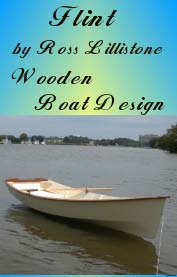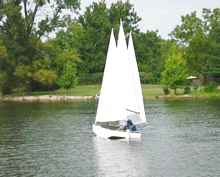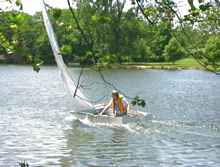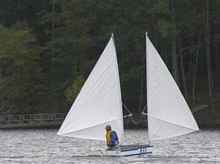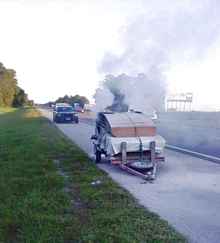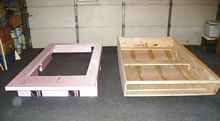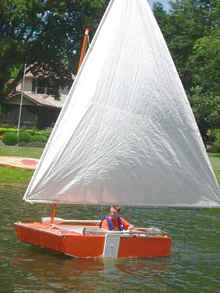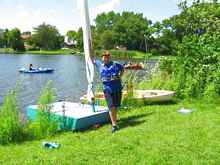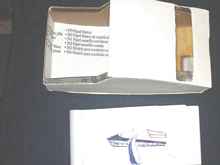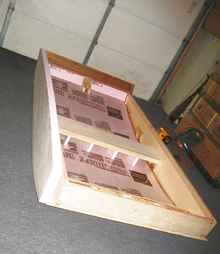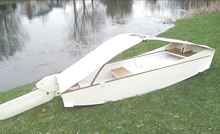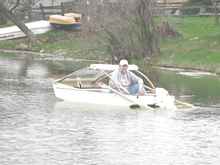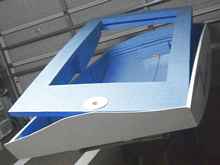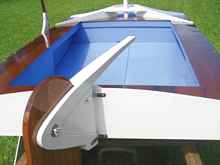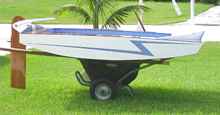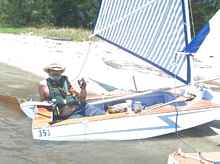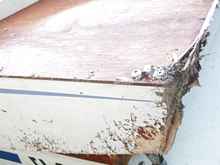Part One - Part Two - Part Three
With John and Andy’s boats, hulls # 134 and #135, I began integrating the framing with the sides and transoms rather than building a frame and then covering it with plywood. My next personal PDRacer was Wild Duck, #143. This boat was constructed in similar fashion but also built to set a record for the amount of sail carried by a PDRacer. Most of the time, I sailed her with a biplane rig—two 52 sq. ft. leg o’ mutton sails, one on each bow corner, but for the record attempt, I stepped a third 60 sq. ft. leg o’ mutton in the middle between the two other sails, bringing the total to 164 sq. ft.
Wild Duck could also be sailed with just a single sail if the wind was too brisk. Counting the two ducks I helped John and Andy complete, Wild Duck was the fourth PDRacer to come out of my garage in Fishers, IN on Lake Vista. Later, Wild Duck would be the only boat of my five-boat fleet to go with me when we moved to Florida. I learned a great deal from Wild Duck about how the Center of Effort of sails shifts with different sail and leeboard positions when sailing with twin sails.
|
With her biplane rig, Wild Duck caused quite a stir at the 2005 Midwest Messabout. |
|
Triple leg o’ muttons helped Wild Duck set a record for the most sail carried for one mile both up and down wind. |
|
Wild Duck was no slouch with only one sail to power her if there was any wind. |
|
Wild Duck spreads her wings going downwind in the 2009 Worlds. Faulty positioning of her leeboard made it difficult to turn into the wind, and I placed an embarrassing 10th. I also had two double penalty turns for hitting boats and buoys. |
|
This was the last rebuild for Wild Duck before setting out for the 2011 Worlds in Oklahoma. This boat had unusual step-down gunwales and an add-on transom for trolling motor use. |
|
Wild Duck goes up in smoke at the north end of Florida’s Turnpike about three hours into my trip to Oklahoma. This photo was taken shortly after a Florida Highway Patrolman exhausted his extinguisher in an effort to put out the fire. |
|
Scow # 10 for me was a build with Tom Heiser of Muncie, IN. Tom wanted a boat with plenty of flotation, so I devised a removable foam insert to fit inside the hull. |
|
Tom opted for a big lateen on his PDRacer, named the Amakusa Duck #223. |
|
PDRacer #6 for me was to construct #241 along with Daniel Mieth, a young man who lived across the lake from us. Daniel sailed to victory in our 2007 regatta. |
John Nystrom and I talked at length about running the Texas 200 in the spring of 2007. One of the designs that came out of that discussion was for a lightweight boat that had a polytarp “cabin” that could be rolled up or extended bow to stern for sleeping. That design was only partially realized with hull #199 Webfoot. This boat had a foam bottom covered with fiberglass and a tarp covering that could be rolled up or extended bow to stern over a mahogany arch framework. Although the boat never made it to Texas, it was an interesting PDRacer concept boat. The hull was very light, and going downwind, there was no need to row or put up sail. The forward part of the polytarp cabin caught enough air to propel the boat downwind without help from oars or sails. For some reason, I made Webfoot only 44” wide, and it had two foam sides that had to be attached to make it a “legal” PDRacer. There were little “tabs” fore and aft on the bottom that fit into the foam sides for attachment. Interestingly, I could also use these tabs to steer when the sides were not attached. Dunk a stern tab and I would begin rounding up in that direction. I also learned how strong an arch could be if it were glued together in the arched position. Two 2”x 3/16” x 8’ strips of mahogany lathing made strong enough support pieces that the boat could be rolled over on its top and the arches would easily support the hull. I am using this “glued arch” concept in lieu of chines on a PDRacer kit I am currently preparing for a father-son team project in PA..
This boat, scow #12, was the last boat I built before moving to Florida in 2009.
|
I rarely make a model of boats I intend to build, but I did make a small cardboard model of Webfoot. |
|
Webfoot was made of Styrofoam and 2mm marine plywood. Even the seat and its supports were mostly foam covered with thin plywood. In this photo, the foam sides are temporarily attached. |
|
The “tabs” for the foam sides are clearly visible in this shot. |
|
This shot shows the cover fully rolled out and attached. If I sat on the bottom and not on the seat, I could sit up under the canopy. I never got around to finishing the side panels before I sold this boat. |
|
Here I am being powered downwind by the wind alone—no need for the oars going this direction. |
|
This was the only photo I could find of this boat sailing with the foam side panels attached. I had a temporary mast up and a very small leg o’ mutton (about 40 sq. ft.) attached. |
When I first moved to Florida, I was undecided about whether I wanted to continue to be involved with building small boats and sails or try my hand at something else. For the first few months, I tried satisfying my sailing urges by joining the US Sailing Center in nearby Jensen Beach, but I soon found myself doing mostly maintenance work on their large fleet of Optis and that just didn’t tickle my trigger. With my ex-Navy son just down the road and without a boat for the upcoming 2009 PDRacer World Championship near Atlanta, my course was clear: it was time to build another scow. I spent quite a bit of time doodling designs that I thought might appeal to Ryan, and the final result was hull #351, the Z-PDR.
The Z featured some departures from my PDRacer designs of the past. She was clearly meant to be a racing boat with her curved sheer, low profile, humped transom tops, wishbone rudder case, tall, raked mast, and battened PolySail. When launched, she proved lightweight and fast even though she carried only 58 sq. ft. of sail. Unfortunately, her bottom was made from Home Depot’s crappy 5mm lauan, and Ryan regularly stepped through voids or holed the bottom on the Intercoastal Waterway’s shallow bottom. A couple of skids helped with the problem, but those were not the only bashings the Z would suffer as the unlucky scow #13 in my 4’ x 8’ scow history. Read more about the development of this boat at:
https://www.polysail.com/zduck.htm and https://polysail.com/zduckupdate.htm
|
The Z had a foam insert for flotation and for stiffening the hull. I’ve found there is no oil-canning with a foam-reinforced hull. |
|
Here’s a view of the Z’s Spartan cockpit and wishbone kickup rudder case. Only the hiking strap is missing in this photo. |
|
Here is the finished hull loaded on my wheelbarrow/boat cart ready for rigging. Note her gently curved sheer. |
|
Ryan tests his boat on the ICW as we readied for the 2009 Worlds. He would hole the bottom on his second test run, and I had to make emergency repairs shortly before leaving for Atlanta and the 2009 worlds. |
|
At the 2009 Worlds at Allatoona Lake, Ryan placed 4th overall. He might have placed much better if I had not delayed his start in the third race by having him assist me with some repairs on Wild Duck. Still, he performed well for a rookie. |
|
In this photo, Ryan is battling with Michael Storer in the white boat with the lug sail on a downwind run. Ryan was able to outsail Michael on this downwind run. In the background is eventual winner Shawn Payment. |
|
Paul “Froggie” Boucher relaxes in the Z after we enjoyed a morning sail across the ICW. Unfortunately, we relaxed too long on this beach and faced a rough passage back across the lagoon. |
|
The Z caught a corner on a wave, pitchpoled, and was dismasted. Froggie lost his shirt, wallet, and Sailor Jerry. In spite of our efforts to save her, the Z ended her day wedged under the Hutchison Island Causeway getting battered against this piling’s barnacles. |
|
Here’s a photo of the starboard bow corner after the beating. Fortunately, the stout cedar framing held up and the hull was not penetrated. After considerable restoration work, the Z has been revived and Rick Landreville is expected to sail her in the 2012 Worlds. |
To be continued next month... |


